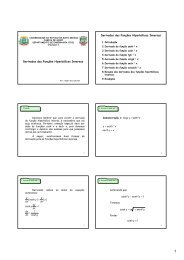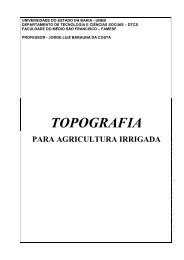Anuário Brasileiro do Arroz 2011 - Unemat
Anuário Brasileiro do Arroz 2011 - Unemat
Anuário Brasileiro do Arroz 2011 - Unemat
You also want an ePaper? Increase the reach of your titles
YUMPU automatically turns print PDFs into web optimized ePapers that Google loves.
Inor Ag. Assmann<br />
28<br />
Global crop<br />
Brazilian crop is integrated with Mercosur and connected to the<br />
world, under the influence of international chains and prices<br />
When the Brazilian rice production<br />
volumes suffered a frustration in excess of<br />
1.3 million tons in the 2009/10 crop year,<br />
the growers expected higher prices for the<br />
commodity as a result of reduced offer, in<br />
line with historical trends, to wit: smaller<br />
crops, higher prices, and vice-versa. But<br />
prices dropped, in a clear demonstration<br />
that the market has changed and is now<br />
chained to Mercosur and connected to the<br />
world.<br />
Surpluses from Argentina, Paraguay<br />
and Uruguay filled the gap in Brazil.<br />
Strong competition also came from the<br />
United States and Asia. It means that the<br />
market has changed and rice has become<br />
a part of the “global village” since the<br />
2005/06 crop, when Brazil stepped out<br />
of the list of the 10 biggest rice importers<br />
and joined the list of rice exporting<br />
countries.<br />
Rio Grande <strong>do</strong> Sul, which accounts for<br />
more than 65% of the entire Brazilian<br />
production, has set a target for shipping<br />
abroad 10% of the crop, as a manner to<br />
get rid of surpluses. Depending on the<br />
year, this represents from 750 to 900<br />
thousand tons. It counterbalances the imports<br />
from Mercosur, which always impart<br />
a negative impact on <strong>do</strong>mestic prices.<br />
In the meantime, over an eight-year<br />
period, the State gradually increased its<br />
annual crop by three million tons, through<br />
technology and management maximization<br />
acts, filling the gap left by the<br />
Brazilian regions that produce dryland<br />
rice. The centralization of the crop in<br />
South Brazil (70% of the national production<br />
volume), expanded by the Mercosur<br />
surpluses, is bound to concentrate the<br />
supply side and alter the market.<br />
“Brazil is now a part of the internation-<br />
al scenario and has to adjust to the rules<br />
of this market”, explains Patricio Méndez<br />
del Villar, analyst with the Center for<br />
International Cooperation in Agronomic<br />
Research for Development (Cirad, in the<br />
French acronym). According to him, having<br />
exported 620 thousand tons and imported<br />
1.05 million in 2010/11, the country<br />
occupies an important position in the<br />
global market. “International prices will<br />
greatly influence prices at home. Brazil’s<br />
market is open to rice from Mercosur countries<br />
and, if demand exists, even to third<br />
party countries, like the United States,<br />
Thailand and Vietnam, which are all very<br />
competitive”, he explains. On the other<br />
hand, Vilar understands that Brazil could<br />
appear on the list of huge exporters, shipping<br />
abroad upwards of a million tons a<br />
year in the near future. “The challenge<br />
consists in conquering obstacles, like excessive<br />
taxation, high production costs,<br />
logistic hurdles and the exchange rate.<br />
There are also favorable factors, like the<br />
quality acknowledged by some clients,<br />
the sector’s motivation, the identification<br />
of the business by the trading companies<br />
and some advantages in terms of freight,<br />
particularly to Africa”, he points out. In<br />
the analyst’s view, the big problem of the<br />
moment is the price.<br />
CHANGE NEEDED The analyst<br />
with Agrotendências Consultoria em<br />
Agronegócios Tiago Sarmento Barata<br />
says the new reality requires the growers<br />
to adapt. “In the international market,<br />
prices range from US$ 10 to US$ 12 a<br />
sack, on average. This is the Mercosur and<br />
the international reference, but surely way<br />
below the Brazilian production cost. This<br />
scenario can be altered only with struc-<br />
tural changes, like a reduction of the tax<br />
burden on inputs, external and internal<br />
sales, less export red tape and logistic efficiency”,<br />
he mentions.<br />
According to Barata, emergency measures<br />
intended to artificially push up farm<br />
gate prices would only delay the problem<br />
and turn the national market even more<br />
attractive to the cereal from Mercosur<br />
countries. He exemplifies saying that<br />
a 50-kg sack of rice in the husk at R$<br />
25.80, minimum price for the 58-percent<br />
whole kernel pattern, would amount to<br />
US$ 15.83 with the <strong>do</strong>llar at R$ 1.63 in<br />
early April. “A highly attractive price for<br />
the Brazilian Northeast and Southeast to<br />
bring in rice from Uruguay and Argentina<br />
for US$ 10 to US$ 12, in terms of equivalence”,<br />
he explains. In his opinion, the<br />
important emergency measures have to<br />
<strong>do</strong> with product sales. “Rice must be channeled<br />
out of Rio Grande <strong>do</strong> Sul, whether to<br />
third countries or to consumers in other<br />
regions”, he states.<br />
Analysts maintain that commercialization<br />
mechanisms are very important,<br />
but must come in the company of structural<br />
actions that reduce the production<br />
cost and improve the efficiency of crop<br />
sales, especially in Rio Grande <strong>do</strong> Sul.<br />
Barata has no <strong>do</strong>ubts about the difficulty<br />
in following this course, which<br />
will obviously demand sacrifices. “Brazil<br />
has already understood its connection<br />
with the world in terms of supply and<br />
demand, but some sectors are still reluctant<br />
in understanding that this connection<br />
also holds for the prices, a fact<br />
that requires urgent adjustments if<br />
competitiveness is to be recovered. This<br />
is the biggest challenge for the sector”,<br />
he concludes.


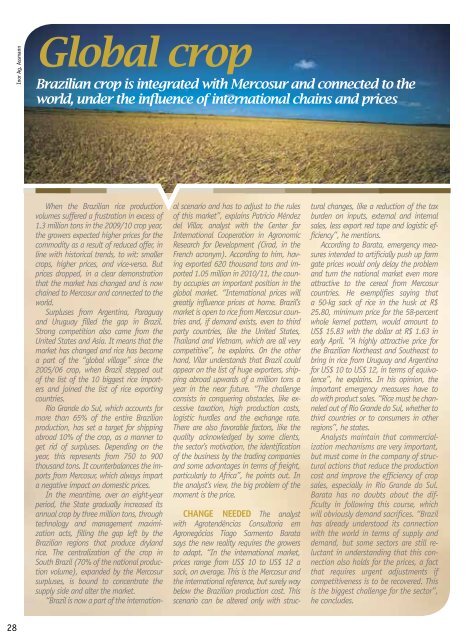
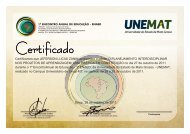
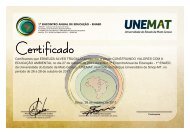
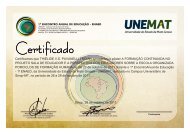
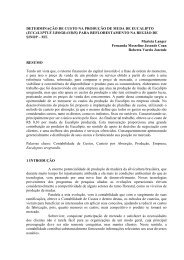
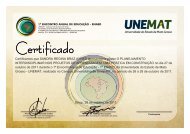
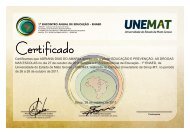
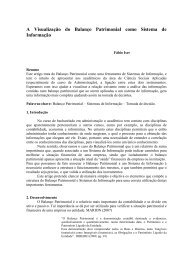
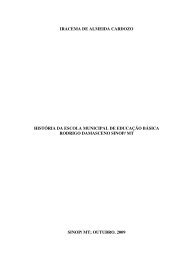

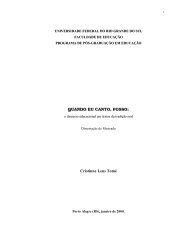
![Aula 31 - Funções Hiperbólicas [Modo de Compatibilidade] - Unemat](https://img.yumpu.com/14334654/1/184x260/aula-31-funcoes-hiperbolicas-modo-de-compatibilidade-unemat.jpg?quality=85)
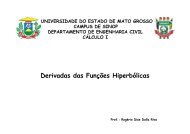
![Aula 31 - Funções Hiperbólicas [Modo de Compatibilidade] - Unemat](https://img.yumpu.com/14332146/1/190x135/aula-31-funcoes-hiperbolicas-modo-de-compatibilidade-unemat.jpg?quality=85)
